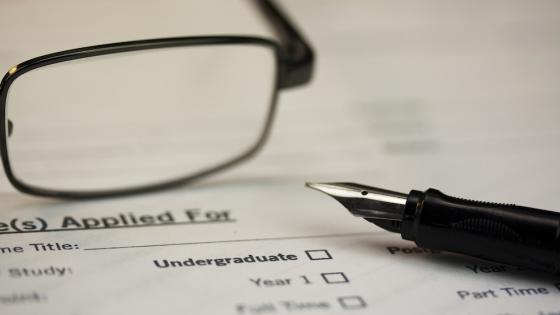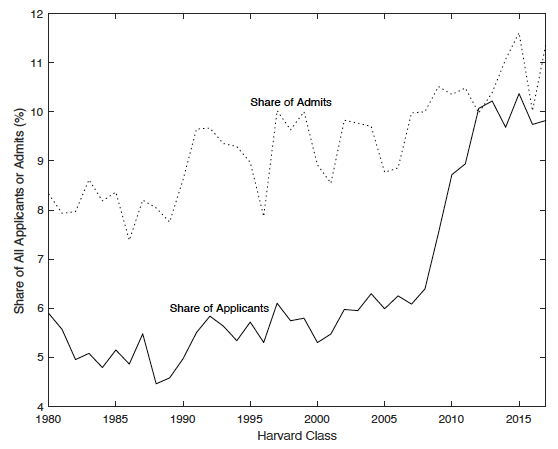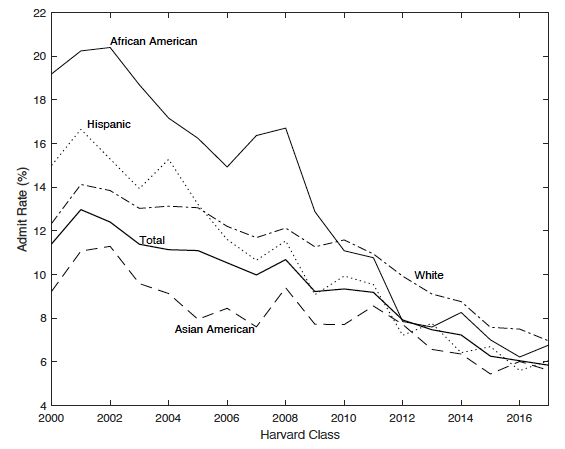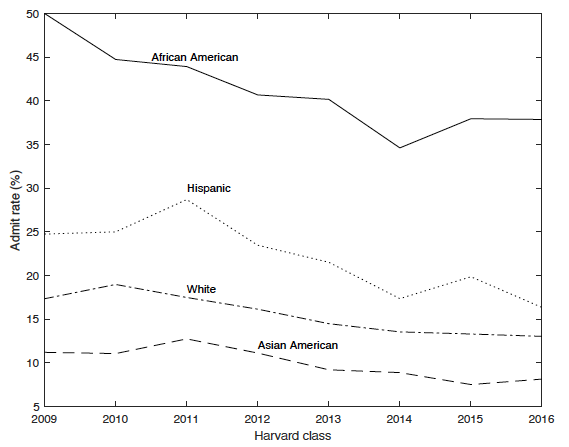Over the past 20 years, applications to elite universities in the US have skyrocketed, with little change in the number of admits (DeSilver 2019). Admission rates at top schools are now commonly below 10%. Part of the reason for these low admission rates is that universities actively recruit applicants by sending them brochures and electronic messages.
Colleges recruit broadly in order to find a more talented or diverse student body or to increase the number of students who pay full tuition. Until recently, a university’s admission rate was also used as a criterion for the US News & World Report rankings (Morse et al. 2018), which gave universities an incentive to maximise their total number of applications.
An integral part of this recruitment strategy is universities’ ability to purchase student contact information from centralised testing agencies such as the College Board. For example, Howell et al. (2019) found that the average number of institutions purchasing a student’s contact information in 2015–2016 was over 28.
The case of Harvard University
In our study (Arcidiacono et al. 2019), we use data made public in the Students for Fair Admissions v. Harvard lawsuit to examine Harvard’s recruiting strategies. The university sends out recruitment letters based on students’ standardised test scores – it sent out over 114,000 letters to admit just over 2,000 students for its class of 2018 – but we found that it used substantially different score cut-offs by race or ethnicity. For example, African American and Hispanic students needed to score a 1,170 out of 1,600 on their SATs (the 78th percentile) to qualify for a recruiting letter. In contrast, Asian American men needed to score a 1,380 (93rd percentile) to qualify.
Beyond sending letters to high-achieving students, Harvard also recruits through direct outreach. Alumni who serve as interviewers for prospective students in the application process may be asked to personally recruit certain students. Harvard admissions officers tour the US and meet with groups of invited prospective students. Under Harvard’s Undergraduate Minority Recruitment Program, over 20 undergraduate student coordinators reach out to minority students and visit schools with large concentrations of minority students.
Data from Harvard show that a large portion of the African American applicant pool effectively has no chance of being admitted based on secondary school grades and entrance exam scores alone. Excluding recruited athletes, children of alumni or Harvard faculty, and those of interest to the Dean of Admissions (either because of donation history/prospects or celebrity status), 41% of African American applicants are in the bottom decile based on academics, and their admission rate was 0.03%.
Other documents made public as part of the lawsuit show that African Americans did not always face such low admission rates. Starting with the class of 2008, the share of African Americans among applicants increased sharply (Figure 1). This increase was accompanied by a steady decrease in the average SAT score of African American applicants (Figure 2).
Figure 1 African American share of applicants and admits, Harvard classes of 1980–2017
Source: Figure 2(a), Aricidiacono et al. (2019)
Figure 2 SAT scores of African American applicants and admits, Harvard classes of 2000–2017
Source: Figure 2(b), Aricidiacono et al. (2019)
Over the same period, the admission rate for African Americans plummeted, from over 16% to under 9% (Figure 3). However, the admission rate for African Americans scoring 750 or above (out of 800) on the SAT math exam was consistently over 35% during the same period (Figure 4).
Figure 3 Unconditional admit rates by race, Harvard classes of 2000–2017
Source: Figure 5(a), Aricidiacono et al. (2019)
Figure 4 Admit rates by race, SAT math scores >740, classes of 2009–2016
Source: Figure 5(b), Aricidiacono et al. (2019)
Potential reasons for recruiting low-scoring African Americans
Harvard appears to have been recruiting low-scoring African Americans for some time. However, it is not clear exactly why this is happening. We suggest two potential reasons: (1) changes in Harvard’s financial aid system, and (2) US judicial rulings surrounding racial preferences in college admissions.
Prior to the class of 2009, Harvard implemented the Harvard Financial Aid Initiative (HFAI), which exempted students from families earning $40,000 or less from paying any tuition, and greatly reduced the financial burden for students from families earning between $40,000 and $60,000. Harvard may have expanded its recruitment to students who would benefit from HFAI, and since African Americans tend to come from less-advantaged households, the rise in (relatively) low-test-score applications could be especially strong for this group. However, this is unlikely to have been a major driver: Avery et al. (2006) showed that the introduction of HFAI had very little effect on the income composition of the class of 2009.
Second, the US Supreme Court decided two cases on racial preferences in college admissions just prior to the class of 2008 application cycle. Harvard may have expanded its recruitment to low-test-score African Americans in an effort to align the admission rates for the four major racial/ethnic groups with one another. Aligning the admission rates in this way would make it appear as if race is a limited factor in the admissions process, in the event of future litigation.
Concluding remarks
Recruiting applicants is a common practice among universities in the US. Relatively little is known about the effects of such recruiting practices since data on university admissions processes is scarce. We focused on Harvard University because documents about its recruitment and admissions process were made public as part of a recent lawsuit. Harvard recruits many applicants who essentially have no chance of being admitted, and this is particularly true for African Americans.
Recruiting students who are unlikely to be admitted might help a university increase its prestige by lowering its admission rate, but such a practice is not without costs. One such cost is that it reduces the credibility of information from colleges in a market that is already information-starved among low-income students. There has been a great deal of recent research devoted to resolving information frictions and credit constraints on the supply side of the college market. Our findings highlight the critical value of credible information to prospective students.
Authors’ note: Peter Arcidiacono served as an expert witness for Students for Fair Admissions, Inc. (SFFA) in the SFFA v. Harvard case. SFFA is not funding his work on this column. Josh Kinsler worked as a consultant for SFFA in the SFFA v. Harvard case. SFFA is not funding his work on this column. The views expressed and conclusions reached in this column are those of the authors; they do not purport to reflect the views of SFFA. To the extent this column relies on records from the SFFA v. Harvard case, it relies solely on the public records from the case.
References
Arcidiacono, P, J Kinsler and T Ransom (2019), “Recruit to reject? Harvard and African American applicants”, NBER Working Paper 26456.
Avery, C, C Hoxby, C Jackson, K Burek, G Pope and M Raman (2006), “Cost should be no barrier: An evaluation of the first year of Harvard’s Financial Aid Initiative”, NBER Working Paper 12029.
DeSilver, D (2019), “A majority of US Colleges admit most students who apply”, Pew Research Center.
Howell, J, M Hurwitz and J Smith (2019), “The impact of college outreach on high schoolers’ college choices: Results from over 1,000 natural experiments”, working paper.
Morse, R, E Brooks and M Mason (2018), “How US News calculated the 2019 best colleges rankings”, US News & World Report.










